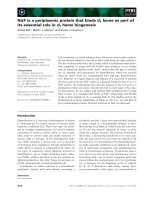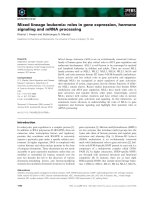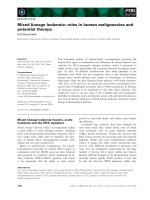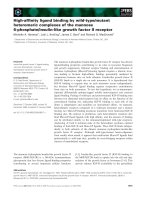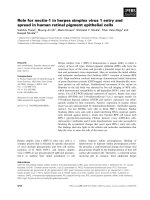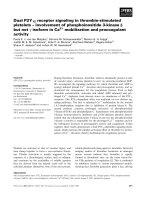Báo cáo khoa học: "Ultrasound-guided central venous catheterization in cancer patients improves the success rate of cannulation and reduces mechanical complications: A prospective observational study of 1,978 consecutive catheterizations" pps
Bạn đang xem bản rút gọn của tài liệu. Xem và tải ngay bản đầy đủ của tài liệu tại đây (260.35 KB, 7 trang )
RESEARC H Open Access
Ultrasound-guided central venous catheterization
in cancer patients improves the success r ate of
cannulation and r educes mechanical complications:
A prospective observational study of 1,978
consecutive catheterizations
Luigi Cavanna
1*
, Giuseppe Civardi
2
, Daniele Vallisa
1
, Camilla Di Nunzio
1
, Lorella Cappucciati
1
, Raffaella Bertè
1
,
Maria Rosa Cordani
1
, Antonio Lazzaro
1
, Gabriele Cremona
1
, Claudia Biasini
1
, Monica Muroni
1
, Patrizia Mordenti
1
,
Silvia Gorgni
1
, Elena Zaffignani
1
, Massimo Ambroggi
1
, Livia Bidin
1
, Maria Angela Palladino
1
, Carmelina Rodinò
1
,
Laura Tibaldi
3
Abstract
Background: A central venous catheter (CVC) currently represents the most frequently adopted intravenous line
for patients undergoing infusional chemotherapy and/or high-dose chemotherapy with hematopoietic stem-cell
transplantation and parenteral nutrition.
CVC insertion represents a risk for pneumothorax, nerve or arterial punc tures. The aim of this prospective
observational study was to explore the safety and efficacy of CVC insertion under ultrasound (US) guidance and to
confirm its utility in clinical practice in cancer patients.
Methods: Consecutive adult patients attending the oncology-hematology department were eligible if they had
solid or hematologic malignancies and required CVC insertion. Four types of possible complication were defined a
priore: mechanical, thrombotic, infection and malfunctioning.
The patient was placed in Trendelenburg’s position, a 7.5 MHZ puncturing US probe was placed in the
supraclavicular site and a 16-gauge needle was advanced under real-time US guidance into the last portion of
internal jugular vein. The Seldinger technique was used to place the catheter, which was advanced into the
superior vena cava until insertion into right atrium. Within two hours after each procedure, an upright chest X-ray
and ultrasound scanning were carried out to confirm the CVC position and to rule out a pneumotorax. CVC-related
infections, symptomatic vein thrombosis and malfunctioning were recorded.
Results: From December 2000 to January 2009, 1,978 CVC insertional procedures were applied to 1,660
consecutive patients. The procedure was performed 580 times in patients with hematologic malignancies and
1,398 times those with solid tumors. A single-needle puncture of the vein was performed on 1,948 of 1,978
procedures (98.48%); only eighteen attempts among 1,978 failed (0.9%).
No pneumotorax, no major bleeding, and no nerve puncture were reporte d; four cases (0.2%) showed self-limiting
hematomas. The mean lifespan of CVC was 189.7 +/- 18.6 days (range 7-701). Symptomatic deep-vein thrombosis
of the upper limbs developed in 48 patients (2.42%). Catheter-related infections occurred in 197 (9.96%) of the
catheters inserted. They were successfully treated with antibiotics and only in 48 (2.9%) patients definitive CVC
removal was required for infection and/or thrombosis or malfunctioning.
* Correspondence:
1
Oncology-Hematology Department, Hospital of Piacenza, Piacenza, Italy
Full list of author information is available at the end of the article
Cavanna et al. World Journal of Surgical Oncology 2010, 8:91
/>WORLD JOURNAL OF
SURGICAL ONCOLOGY
© 2010 Cavanna et al; licensee BioMed Central Ltd. This is an Open Access article dis trib uted under the terms of the Creative
Commons Attribution License ( which permits unrestricted use, distribution, and
reproduction in any medium, pr ovided the original work is properly cited.
Conclusions: This study represents the largest published series of consecutive patients with cancer undergoing
CVC insertion under US guidance; this procedure allowed the completion of the therapeutic program for 1,930/
1,978 (97.6%) of the catheters inserted. The absence of pneumotorax and other major complications indicates that
US guidance should be mandatory for CVC insertion in patients with cancer.
Background
Central venous access is essential in patients with can-
cer, an d the need for intravenous access devices fo r the
administration of cancer therapy has increased propor-
tionally with the increasing number of patients diag-
nosed with c ancer. The percutaneous approach to the
subclavian or internal jugular vein is current ly the most
popular procedure for placing catheters in the superior
vena cava both for short-term and long-term use.
Unfortunately, central venous catheter (CVC) insertion
represents a risk of pneumothorax, nerve puncture and
major bleeding (mechanical complications), infection
and CVC-related vein thrombosis [1,2].
Mechanical complications of CVC insertion without
ultrasound (US) guidance, such as arterial puncture and
pneumothorax, are seen in up to 21% of attempts, and
up to 35% of insertion attempts are not successful [3-5].
There have been several prospective randomized trials
[6-14] and two metanalyses [15,16] that suggest the use
of US has been associated with a reduction in complica-
tion rate and an improved first-pass success when pla-
cing CVC in the internal jugular vein.
In 2001, the U.S. Agency for Healthcare Research and
Quality recommended the use of ultrasound for the pla-
cement of CVC as one of their 11 practices to improve
patient care [17,18]. However a survey of 250 anesthe-
tists in the United Kingdom found that 41% disagreed
or strongly disagreed with the recommendation that
ultrasound imaging should be the preferred method for
insertion of a central venous catheter in the internal
jugular vein [19].
In addition, a report in the United States also showed
that <15% of surgery, anesthesia, i nternal medicine,
emergency medicine and family medicine housestaff
used ultrasound guidance for most CVC placements
[20].
Since in our department oncologists and hematologists
have performed ultrasound imaging procedures as well
as interventional ultrasound in clinical practice for
patient management (diagnosis, staging, restaging and
follow-up) for almost 25 years [21-27], t his procedure
was early applie d as a guidance for CVC insertion in the
internal jugular v ein in cance r patients before the
recommendations from the Agency for Healthcare
Research and Quality were available [17,18]. Aims of
this prospective obs ervational study were to evaluate the
safety and the efficacy of ultrasound-guided insertional
CVC in patients with hematological and solid tumors, to
confirm the utility of this procedure in clinical practice,
and to evaluate local or systemic infection, CVC-related
deep venous thrombosis (DVT) and lifespan of the CVC.
Materials and methods
Adult patients with hematologic and solid tumors
admitted to the oncology-hematology department of the
hospital of Piacenza, North Italy, and requiring an
indwelling CVC were offered the opportunity to parteci-
pate in the study. There were 802 women (48%) an d 858
men (52%) with a mean age of 61.72 years (range 18-85).
No exclusion criteria were contemplated except patients’
refusal and patients candidate to palliative care only. The
study w as approved by the l ocal ethics committee as a pro-
spective observational study, and all the patients ga ve
informed written consent before enrolment. Three types of
CVC were employed according to different indications: sin-
gle-lumen 16 gauge and, double-lumen Becton Dickinson
(Singapore), double-lumen 13 French Arrow International
(Erding, Germany). The last one was specifically employed
in leukapheresis procedures. Each CVC-positioning is con-
sidered a single procedure for the study; so a patient who
need catheter insertion more than once through his clinical
history was registered as a new procedure every time CVC
was inserted again.
The indications of CVC were: chemotherapy delivery,
transfusion, parenteral nutrition, leukapheresis, autolo-
gous and allogenic stem cell transplantation, invasive
hemodynamic variables assessment and blood sampling.
Patients candidate to palliative care only were excluded
from this study since they were enrolled in a different
study.
Operators included t wo physicians and a nurse with
specific experience with ultrasound and ultrasonically
guided procedures, so that the level of experience of the
operators would not bias results.
Patients were postured in the Trendelenburg’s position
with the head rotated toward the opposite side. The CVC
was routinely implanted on the right side; however, if
conditions were unsuitable for implantation on this side,
such as in the case of lymphoadenopathy, or postradia-
tion therapy area, or at the patient’ srequest,theCVC
was placed on the left side. All procedures were per-
formed using standard aseptic techniques and a local
anesthesia with a very small, 22-gauge needle for the
venipuncture was applied under ultrasound guidance.
Cavanna et al. World Journal of Surgical Oncology 2010, 8:91
/>Page 2 of 7
The ultrasound examinations were performed using
ESAOTE (Genova, Italy) equipped with two transducers
between 3.5 to 7.5 MHZ, with a needle guide, without a
sterile cover. The method that we commonly use is “the
three-handed method” [28]; this method requires an assis-
tant to hold the probe, while the operator controls the
needle and performs the procedure under real-time gui-
dance, and the nurse helps the two physicians during the
maneuver.
The central vein was identified along its greater longitu-
dinal axis and its relationship with other anatomical struc-
tures using Valsalva’ s maneuver which determines an
increase of the diameter of the veins. Under ultrasound-
guide in real time, a 16-gauge needle is introduced into
the last portion of internal jugular vein. This vein was
reached through the transduc er placed at the point of
insertion of the sternocleidomastoid muscle into the clavi-
cular; the correct introduction of the needle was always
confirmed by ultrasound guidance and by the easy aspira-
tion of venous blood.
The Seldinger tec hnique was used to place the cathe-
ter, which was advanced into the superior vena cava
until insertion into right atrium.
Every procedure was scheduled in order to register
patient’s data, pathological diagnosis, indications for CVC
insertion, type of CVC, number of attempts and early
complications if any failure; the procedures were observed
by an independent team. Medications, CVC-related blood
stream infection, symptomatic deep-vein thrombosis and
CVC removal or substitution were also recorded. Within
two hours after each procedure, chest radiography and
ultrasound scanning were carried out to exclude pneumo-
torax and to evaluate correct catheter position. At the end
of treatment or when required, after the removal of the
catheter, the tip was sent to the laboratory for bacteriologi-
cal examination.
No systemic prophylaxis against deep-vein thrombosis
was adopted and no antibiotic prophylaxis was m ade.
Each catheter at the end of its routine use was flushed
with 20 ml normal sterile saline, then 5 ml heparinized sal-
ine (50 IU/ml). Follow-ups for each patient were sched-
uled every 10 days during the first six months, or until
removal of the CVC. The follow-up consisted of: patient’s
clinical examination, catheters flushed with heparinized
solution and catheter exit side dressing.
Assesment of endpoints
The primary endpoints were: number of pneumotorax,
accidental arterial and nerve puncture; major bleeding;
number of attempts; failure; local hematoma.
Secondary endpoints were: symptomatic vein throm-
bosis o f upper limbs (early or late), infections, malfunc-
tioning and lifespan of the CVC.
In cases of clinical suspicion of venous thrombosis
evidenced by progressive arm or facial swelling, the
ultrasound criteria we considered in order to show
the presence of catheter-related thrombosis included
visualization of thrombus, absence of spontaneous flow,
dilatation of the vein by the Valsalva maneuver and
compressibility of the jugular vein as previously reported
[29,30]. Infections were defined as catheter-related bac-
teremia: isolatio n of the same organism from the cathe-
ter in the presence of more than 15 colony-forming-
units (CFUs) and positive blood culture without clinical
sig ns of infection and catheter-related septicemia: isola-
tion of the same organism from the catheter in the pre-
sence of more than 15 CFUs and positive blood culture,
with clinical signs of i nfection [29]. Infections with a
clinically apparent focus other than exit site or catheter
were excluded. Catheter malfunctioning occlusion was
registered when presented.
Statistical analysis
Demographic data and clinical features were analyzed
using descriptive methods. Quantitative variables were
summarized using mean and standard deviation. Catego-
rical variables were summarized as counts and percen-
tages. Baseline analysis included all enrolled p atients.
Statistical tests were performed with Statview Software,
latest version.
Results
From 2 December 2000 to 31 January 2009, 1,978 CVC
insertional procedures were applied in 1,660 patients.
The procedure was performed 580 times in hematologic
malignancies and 1,398 times in solid tumors (Table 1);
the majo rity of patients with solid tumors had gastroin-
testinal cancer and the majority of patients with hema-
tologic malignancies had lymphomas (Table 2).
The median platelet count at the ti me of CVC insertion
was 236,000/mm3 while the median neutrophil count
was 4,015/mm3 (Table 3). It must be emphasized that a
subset of patients, especially hematological ones, had
Table 1 Patients characteristics
N
o
of patients % of patients
Total 1,660 100
Median age 61.71 years (range 18-85)
Male 858 52
Female 802 48
Type of cancer
Solid tumor 1,280 77
Hematologic malignancies 380 23
Cavanna et al. World Journal of Surgical Oncology 2010, 8:91
/>Page 3 of 7
neutropenia and low platelet count; neutropenia:
254 patients (15.3%) with neutrophils below 1,500/mm3,
132 (7.95%) below 500/mm3, 88 (5.3%) below 100/mm3;
low platelet count: 116 patients (6.99%) with platelet
count below 50,0 00/mm3, 70 (4.22%) be low 20,000/
mm3 and 38 (2.29%) below 10,000/mm3 (Table 4).
Primary end points: a single-needle puncture of the
vein was performed on 1,948 of 1,978 procedures
(98.48%) and eighteen attempts of the 1,978 failed
(0.9%), so the procedure revea led itself to be efficacious
in 99.1% of cases. Failures were caused by arterial punc-
ture in 6 (0.3%), mediastinumCVCdislocationin2
(0.1%), vein collapse in 8 (0.48%) and no efficacious “eco
window” in 2 (0.1%). There were no dif ferences in
mechanical complications, malposition and malfunction-
ing of CVC with the r ight (94.7% of cases) and left side
(5.3% of cases) approaches.
No major bleeding and no nerve puncture were
reported; four (0.2%) self-limiting hematomas at th e site
of CVC insertion without requiring any medical inter-
vention were registered after arterial puncture. No pneu-
motorax was reported (Table 5).
Secondary end points
Catheter-related infection occurred in 197/1,978 (9.96%)
of the catheters inserted; CVC-related septicemia was
observed in 98 cases (4.95%). No deat h was attributable
to catheter-related infections (Table 6).
The organisms that caused cat heter colonization were
coagulase negative sta phylococci 82%, Escherichia Coli
8%, Pseudomonas 6%, Enterococcus 4%.
The mean lifespan of CVC was 189.7 +/- 18.6 days
(range 7-701), and CVC inserted under US guidance
permitted the delivery of the planned therapy in 1,930/
1,978 (97.6%) of patients.
In our 197 patients with catheter - related infection,
antibiotic therapy resolved t he infection: in 129 cases
(65.5%) with CVC substitution and 20 cases (10.10%)
without it. Only in 48 cases (24.40%) was definitive CVC
removal required for associated thrombosis and for anti-
biotic therapy failure or for CVC malfunctioning.
Symptomatic deep-vein thrombosis of upper limbs
developed in 45 cases (2.7%) mainly in the first 30 days
of implantation. Clinical diagnosis suggested by progres-
sive arm or facial swelling was confi rmed by echodop-
pler. In 30/45 (66.7%) cases with thrombosis, CVC was
removed because of associated infective complications
(Table 6). No patient had any further thromboembolic
complications. There was no difference in infection,
bleeding or thrombosis in patients with single-lumen
and double-lumen catheters; however the large - bore
catheter employed in leukapheresis was generally
removed after the procedure.
Discussion
The use of central venous ac cess devices has become an
essential component o f the treatment of many medical
disorders. Central venous access is commonly attempted
in the internal jugular vein, subclavian vein, femoral
vein, or arm veins using peripherally central catheters. It
is estimated that several million devices are inserted
each year, facilitating many emerging therapies, includ-
ing long-term chemotherapy [30].
Central venous cannulation can be unsafe: the
National Confidential Enquiry into perioperative deaths
has reported one death resulting from a procedure-
induced pneumothorax [31].
It must be emphasized that less serious discomfort
(though unplea sant for the patient), clinician time, hos-
pital stay and economic costs are variable rates for fail-
ure and complications from cent ral venous cannulation.
Ten of 328 oncologi cal patients (3. 4%) developed pneu-
mothorax after central venous access implanted
without US guidance and 6 of them (60%) required tube-
thoracostomies [30].
More recently, the etiology and incidence of iatrogenic
pneumothorax, which can develop after invasive proce-
dures performed for diagnostic and for therap eutic pur-
poses, has been reported [32]: the most frequent
procedure type causing pneumotorax was central venous
Table 2 Types of cancer
N
o
of procedures % of cancer
Total 1,978 100
Solid tumor 1,398 70.68
Gastrointestinal 904 45.70
Lung 64 3.24
Breast 136 6.88
Other solid cancer 294 14.86
Hematologic malignancies 580 29.32
Lymphomas 216 10.82
Acute leukemia 196 9.91
Multiple myeloma 126 6.37
Other hematologic malignancies 42 2.12
Table 3 Main Hematologic characteristics of the overall
population
Median Range Normal range
Platelet count
N/mm3
236,000 7,000-510,000/mm3 130,000-450,000/mm3
Neutrophil count
N/mm3
4,015 85-10,500/mm3
Prothrombin
activity (%)
60 30-100 70-120 (%)
Fibrinogen
(mg/dl)
185 100-460 150-400 (mg/dl)
APTT (sec) 30 25-45 26.50-37.50 (sec)
Cavanna et al. World Journal of Surgical Oncology 2010, 8:91
/>Page 4 of 7
cat het erization, with 72 patients (43.8%) of the series of
164 patients developing iatrogenic pneumothorax.
In addition, complications are more frequent when
more needle passes are necessary because of a natomical
variation or difficult veins (small veins; no palpable land-
markers). Anatomical variations of t he internal jugular
vein were found in 8% of patients studied with ultra-
sound-guided CVC [33]; the ease and the shorter time
required to perform ultrasound-guided catheterization,
together with the higher rate of suc cess and decreased
incidence of complications make using the ultrasound-
guided CVC preferable to conventional CVC [34-36].
In this large series of 1,978 CVC insertional performed
procedures in 1,660 consecutive patients suffering from
cancer in different phase s of t heir disease, none of the
patients experienced major complications (pneumotorax,
hemothorax, nerve lesions). To our knowledge, this is
the largest series of consecu tive CVC ins ertional pr oce -
dures performed in patients with hematologic malignan-
cies and solid tumors and we have shown that this
technique may be efficacious and safe both in patients
with acute leukemia and with solid tumors. In addition,
we emphasize tha t the catheter was inserted in 254
patients (15.3%) with neutrophils <1,500 ul and 116
patients (6.99%) with platelets <50 ul without complica-
tions. Individu al institution data might differ from those
gathered a t other centers; however we think the results
of this study ar e particularly relevant because they have
been obt ained through a large series of patients investi-
gated wi th an accurate prospective trial performed over
a long period of time. Our results can be favourably
compared with a recent report where adverse ev ents
occurred in 26 cases (5.2%) of 500 US-guided CVC via
subclavian vein, with two cases of pneumothorax [37].
In our study, the rate of CVC-related deep-vein
thrombosis was low despite the absence of antithrombo-
tic drugs in the practice of prophylaxis against venous
thromboembolism in the patients enrolled; the incidence
of symptomatic DVT was quite similar, although a bit
low, with respect to the value in the control arm of pre-
vious studies wh ich compared no systemic prophylaxis
versus deltaparin or low-dose warfarin [38-40]. The low
incidence of upper-limb DVT may be explained by
ultrasound guide as previously stated [41] which allowed
us to achieve the following targets:
1) to identify the exact site of CVC insertion, 2) to
perform o nly one attempt in nearly all the patients
(98.48%), causing little damage to the venous
endothelium: in fact, it is well known that endothe-
lium damage is a main risk factor in initiating
thrombosis.
However the lack of venographic assessment of cathe-
ter-related thrombosis in our study is a limit to the
determination of the real frequency of this complication,
as previously reported [40].
The incidence of CVC i nfective complication was
similar to previous data concerning non-tunnelled
catheters, while it was higher than totally implantable
central venous access ports [29,42]. The great incidence
of staphylococci reflects the classical expositional risk of
this kind of catheter, altho ugh the incidence o f infec-
tions, the rate of CVC withdrawal or malfunction was
low when compared with previous reports [29], since
prompt antibiotic therapy allowed a good control of
bacterial infection. Moreover, our non-tunnelled cathe-
ters were easily replaced whenever clinical conditions
suggested it. In the present study, ultrasound-guided
CVC procedures were performed by our own specifically
experienced oncologists and hematologists, and we agree
with a recent report [28] that ultrasound is an easily
learned technique t hat not only enhances the physical
examination, but has the distinct advantage of being a
portable tool that can provide real-time guidance for
CVC insertion and other interventional procedures such
Table 4 Patients with impaired neutrophil/platelet count who underwent ultrasound guided internal jugular vein
catheterization
Patients with neutropenia 254 of 1660 Patients with low platelet count 116 of 1660
N. Patients % of patients N. neutrophil/mm3 N. Patients % of patients N. Platelet/mm3
254 15.3% <1,500 116 6.99 <50
132 7.95 <500 70 4.22 <20
88 5.3 <100 38 2.29 <10
Table 5 Results of ultrasound guided catheter insertion,
primary endpoints and mechanical complications
N
o
%
Total procedures 1,978 100
Access with one attempt 1,948 98.48
Access with two attempts 12 0,6
Pneumothorax 0 0
Major bleeding 0 0
Arterial puncture 6 0.3
Failure 18 0.9
Local Hematoma 4 0.2
Nerve puncture 0 0
Cavanna et al. World Journal of Surgical Oncology 2010, 8:91
/>Page 5 of 7
as biopsy, abscess drainage, paracentesis, thoracentesis,
etc, and for critically ill a nd elderly patients the proce-
dure can be performed easily at the bedside as previously
reported [21-27]. Physicians with specific experience
were defined as operators who have performed > 50 CVC
insertion under ultrasound guidance [4,28].
It must be emphasized that the use of ultrasound is
not limited to radiologists. The American Medical Asso-
ciation policy fovours ultrasound imaging technique dif-
fusion in medical practice [43], the American College of
Emergency Physicians and the American College of Sur-
geons support the use of ultrasound by members of
their societies and address ways to obtain and maintain
competence as well as ensuring quality control [44,45].
We believe that this technique is very useful also in
the oncology and hematology departm ent, not only for
CVC placement but also for staging, disease control, fol-
low-up and ultrasound guided-procedures [21-27].
Conclusion
Our large study show that ultrasound-guided CVC inser-
tion is a safe and effective technique that is sufficien t to
give a patient six or more months of treatment. Safety
and efficacy of the procedure did not negatively impact
on infective and thrombotic complications. We believe
this technique can be applied easily to most practitioners
in clinical oncology with relevant patient benefits.
Competing interests
The authors declare that they have no competing interests.
Authors’ contributions
Study Concepts: LC, GC, DV. Study Design: LC, GC, DV. Data Acquisition:
From LC to LT. Quality Control of Data and Algorithms: LC, GC, DV and CB.
Data Analysis and Interpretation: CB and LC. Statistical analysis: DV and CB.
Manuscript preparation: LC, CB, CDN. Manuscript editing: LC, CB, CDN.
Manuscript review: all authors.
Acknowledgements
The Authors acknowledge the following institutions for their support:
Commercianti di Agazzano, Comune di Pontenure, Roncarolo, Tramballando,
Club Beppe and Dany, Marco Biolchi, Copravolley, Grande Casa Reale e Ducale
di Piacenza e Parma, Pro Loco Gazzola, I Fantastici.
Author details
1
Oncology-Hematology Department, Hospital of Piacenza, Piacenza, Italy.
2
Department of Medicine, AUSL Piacenza, Italy.
3
Teaching and management
Department of Nursing Staff, AUSL of Piacenza, Italy.
Received: 3 June 2010 Accepted: 19 October 2010
Published: 19 October 2010
References
1. McGee DC, Gould MK: Current concepts: preventing compli cations
of central venous ca theterisation. NEnglJMed2003, 348:
1123-1133.
2. Cortelezzi A, Fracchiola NS, Maisonneuve P, Moia M, Luchesini C, Ranzi ML,
Monni P, Pasquini MC, Lambertenghi-Deliliers G: Central venous catheter-
related complications in patients with hematological malignancies. A
retrospective analysis of risk factors and prophylactic measures. Leu
Lymph 2003, 44:1495-1501.
3. Bernard RW, Sthal WM: Subclavian vein catheterizations: a prospective
study: i. Non-infectious complications. Ann Surg 1971, 173:184-190.
4. Sznajder JI, Zveibil FR, Bitterman H, Weiner P, Bursztein S: Central vein
catheterization: failure and complication rates by three percutaneous
approaches. Arch Intern Med 1986, 146:259-261.
5. Defalque RJ: Percutaneous catheterizations of the internal jugular vein.
Anesth Analg 1974, 53:116-121.
6. Mallory DL, McGee WT, Shawker TH, Brenner M, Bailey KR, Evans RG,
Parker MM, Farmer JC, Parillo JE: Ultrasound guidance improves the
success rate of internal jugular vein cannulation: a prospective,
randomized trial. Chest 1990, 98:157-160.
7. Troianos CA, Jobes DR, Ellison N: Ultrasound-guided can nulation of the
internal jugular vein: a prospective, randomized study. Anesth Analg
1991, 72:823-826.
8. Denys BG, Uretsky BF, Reddy PS: Ultrasound-assisted cannulation of the
internal jugular vein: a prospective comparison to the external
landmark-guided technique. Circulation 1993, 87:1557-1562.
9. Slama M, Novara A, Safavian A, Ossart M, Safar M, Fagon JY: Improvement
of internal jugular vein cannulation using an ultrasound-guided
technique. Intensive Care Med 1997, 23:916-919.
10. Teichgraber UK, Benter T, Gebel M, Manns MP: A sonographically guided
technique for central venous access. AJR Am J Roentgenol 1997,
169:731-733.
11. Nadig C, Leidig M, Schmiedeke T, Höffken B: The use of ultrasound for the
placement of dialysis catheters. Nephrol Dial Transplant 1998, 13:978-981.
12. Hayashi H, Amano M: Does ultrasound imaging before puncture facilitate
internal jugular vein cannulation? Prospective randomized comparison
with landmark-guided puncture in ventilated patients. J Cardiothorac
Vasc Anesth 2002, 16:572-575.
13. Leung J, Duffy M, Finckh A: Real-time ultrasonographicallyguided internal
jugular vein catheterization in the emergency department increases
success rates and reduces complica tions: a randomized, prospective
study. Ann Emerg Med 2006, 48:540-547.
14. Karakitsos D, Labropoulos N, De Groot E, Patrianakos AP, Kouraklis G,
Poularas J, Samonis G, Tsoutsos DA, Konstadoulakis MM, Karabinis A: Real-
time ultrasound guided catheterization of the internal jugular vein: a
prospective comparison to the landmark technique in critical care
patients. Crit Care 2006, 10:R162.
15. Randolph AG, Cook DJ, Gonzales CA, Pribble CG: Ultrasound guidance for
placement of central venous catheters: a meta-analysis of the literature.
Crit Care Med 1996, 24:2053-2058.
16. Hind D, Calvert N, McWilliams R, Davidson A, Paisley S, Beverley C,
Thomas S: Ultrasonic locating devices for central venous cannulation:
meta-analysis. BMJ 2003, 327:361.
17. Rothshild JM: Ultrasound guidance of central vein catheterization. 2001
[ Accessed June 4, 2007.
Table 6 Secondary endpoints and non-mechanical complications of ultrasound guided catheter insertion
N%
Total procedures 1,978 100
CVC-related infection 197 9.96
Septicemia 98 4.95
CVC-related symptomatic vein thrombosis 45 2.28
CVC removal due infection/thrombosis or malfunctioning 48 2.4
Mean lifespan of CVC and standard devation 189.7, days +/- 18.6(range 7-701 days)
Cavanna et al. World Journal of Surgical Oncology 2010, 8:91
/>Page 6 of 7
18. Making health care safer: a critical analysis of patient safety practices.
2001 [ Accessed June 4, 2007.
19. Howard S: A survey measuring the impact of NICE guidance 49: the use
of ultrasound locating devices for placing central venous catheters. 2004
[ />20. Girard TD, Schectman JM: Ultrasound guidance during central venous
catheterization: a survey of use by house staff physicians. J Crit Care
2005, 20:224-229.
21. Cavanna L, Di Stasi M, Fornari F, Civardi G, Sbolli G, Buscarini E, Buscarini L:
Ultrasound and ultrasonically guided biopsy in hepatic lymphoma. Eur J
Cancer 1987, 23(3):323-6.
22. Fornari F, Civardi G, Cavanna L, Di Stasi M, Rossi S, Sbolli G, Buscarini L:
Complications of ultrasonically guided fine-needle abdominal biopsy.
Results of a multicenter Italian study and review of the literature. The
Cooperative Italian Study Group. Scand J Gastroenterol 1989, 24(8):949-55.
23. Sbolli G, Fornari F, Civardi G, Di Stasi M, Cavanna L, Buscarini E, Buscarini L:
Role of ultrasound guided fine needle aspiration biopsy in the diagnosis
of hepatocellular carcinoma. Gut 1990, 31(11):1303-5.
24. Cavanna L, Civardi G, Fornari F, Di Stasi M, Sbolli G, Buscarini E, Vallisa D,
Rossi S, Tansini P, Buscarini L: Ultrasonically guided percutaneous splenic
tissue core biopsy in patients with malignant lymphomas. Cancer 1992,
69(12):2932-6, 15.
25. Civardi G, Vallisa D, Bertè R, Giorgio A, Filice C, Caremani M, Caturelli E,
Pompili M, De Sio I, Buscarini E, Cavanna L: Ultrasound-guided fine needle
biopsy of the spleen; high clinical efficacy and low risk in a multicenter
Italian study. Am J Hematol 2001, 67(2):93-9.
26. Civardi G, Vallisa D, Berte’ R, Lazzaro A, Moroni CF, Cavanna L: Focal liver
lesions in non-Hodgkin’s lymphoma: investigation of their prevalence,
clinical significance and the role of Hepatitis C virus infection. Eur J
Cancer 2002, 38(18):2382-7.
27. Cavanna L, Lazzaro A, Vallisa D, Civardi G, Artioli F: Role of image-guided
fine needle-aspiration biopsy in the management of patients with
splenic metastasis. Word J Surg Oncol 2007, 2:5-13.
28. Feller Kopman-David: Ultrasound-guided Internal Jugular Access: a
proposed standardized approach and implications for training and
practice. Chest 2007, 132:302-9.
29. Harter C, Salwender HJ, Bach A, Egerer G, Goldschmidt H, Ho AD: Catheter-
related infection and thrombosis of the internal jugular vein in
hematologic-oncologic patients undergoing chemotherapy. A
prospective comparison of silver-coated and uncoated catheters. Cancer
2002, 94:245-51.
30. Biffi R, De Braund R, Orsi F, Pozzi S, Mauri S, Goldhirsch A, Nolè F,
Andreoni B: Totally implantable central venous access ports long-term
chemotherapy. Annals of Oncology 1998, 9:767-773.
31. Callum KG, Whimster F: International vascular radiology and
neurovascular radiology: a report of the National Confidential Enquiry
into Perioperative Deaths. Data collection period 1 April 1998 to 31 Mar
1999. London, NCEPOD 2000.
32. Celik B, Sahin E, Nadir A, Kaptanoglu M: Iatrogenic pneumotorax etiology
incidence and risk factors. Thorac Cardiovasc Surg 2009, 57:286-90.
33. Danys BG, Uretsky BF, Reddy PS: Ultrasound assisted cannulation of the
internal jugular vein. Crit Care Med 1991, 87:1557-62.
34. Lameris JS, Post PJM, Zonderland HM, Gerritsen PG, Kappers-Klunne MC,
Schütte HE: Percutaneous placement of Hickmann catheters: comparison
of sonografically guided and blind techniques. Am J Radiol 1990,
155:1097-9.
35. Mallory DL, Megee WT, et al: Ultrasound guidance improves the success
rate of internal jugular vein cannulation. Circulation 1993, 87:1557-62.
36. Cajozzo M, Quintini G, Cocchiera G, Greco G, Vaglica R, Pezzano G,
Barbera V, Modica G: Comparison of central venous catheterization with
and without ultrasound guide. Transfusion and Apheresis Science 2004,
31:199-202.
37. Sakamoto N, Arai Y, Takeuchi M, et al: Ultrasound - Guided Radiological
Placement of Central Venous Port via the Subclavian Vein: A
restrospective Analysis of 500 Cases at a Single Institute. Cardiovasc
Intervent Radiol 2010, 33:989-94.
38. Couban S, Goodyear M, Burnell M, Dolan S, Wasi P, Barnes D, Macleod D,
Burton E, Andreou P, Anderson DR: Randomized placebo-controlled study
of low-dose warfarin for the prevention of central venous catheter-
associated thrombosis in patients with cancer. J Clin Oncol 2005,
23:4063-9.
39. Karthaus M, Kretzschmar A, Kroning H, Biakhov M, Irwin D, Marschner N,
Slabber C, Fountzilas G, Garin A, Abecasis NG, Baronius W, Steger GG,
Südhoff T, Giorgetti C, Reichardt P: Dalteparin for prevention of catheter-
related complications in cancer patients with central venous catheters:
final results of a double-blind, placebo-controlled phase III trial. Ann
Oncol 2005, 17:289-96.
40. Fagnani D, Franchi R, Porta C, Pugliese P, Borgonovo K, Bertolini A, Duro M,
Ardizzoia A, Filipazzi V, Isa L, Vergani C, Milani M, Cimminiello C,
POLONORD Group: Thrombosis-related complications and mortality in
cancer patients with central venous devices: an observational study on
the effect of antithrombotic prophylaxis. Ann Oncol 2007, 18:551-5.
41. Verso M, Agnelli G: Venous thromboembolism associated with long-term
use of central venous catheters in cancer patients. J Clin Oncol 2003,
21:3665-75.
42. Gallieni M, Pittiruti M, Biffi R: Vascular access in oncology patients. A
Cancer J Clin 2008, 58:323-46.
43. American Medical Association: Res. 802, I-99 and Reaffirmed: Sub.Res.
108, A-00; privileging for ultrasound imaging. 2005 [ />WorkArea/DownloadAsset.aspx?id=44304], Accessed March 15, 2006.
44. American College of Emergency Physicians: AECP policy state-ment:
emergency ultrasound guidelines. 2001 [ />aspx?id=32334], Accessed June 4, 2007.
45. American College of Surgeons: Ultrasound examinations by surgeons.
1998 [ />Accessed June 4, 2007.
doi:10.1186/1477-7819-8-91
Cite this article as: Cavanna et al.: Ultrasound-guided central venous
catheterization in cancer patients improves the success rate of
cannulation and reduces mechanical complications: A prospective
observational study of 1,978 consecutive catheterizations. World Journal of
Surgical Oncology 2010 8:91.
Submit your next manuscript to BioMed Central
and take full advantage of:
• Convenient online submission
• Thorough peer review
• No space constraints or color figure charges
• Immediate publication on acceptance
• Inclusion in PubMed, CAS, Scopus and Google Scholar
• Research which is freely available for redistribution
Submit your manuscript at
www.biomedcentral.com/submit
Cavanna et al. World Journal of Surgical Oncology 2010, 8:91
/>Page 7 of 7

